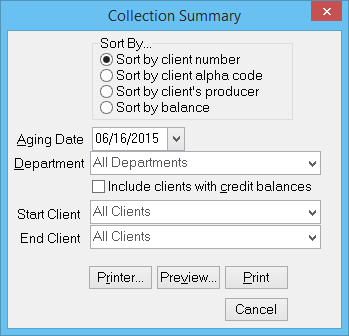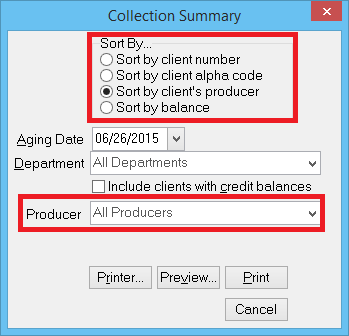Difference between revisions of "Report: Collection Summary"
(updated how to access only) |
|||
| (6 intermediate revisions by 2 users not shown) | |||
| Line 32: | Line 32: | ||
The collection summary provides an aged report for [[Client Profile|clients]] with outstanding balances due to the agency, and includes the client's phone number and the '''D'''ate '''S'''ince '''L'''ast '''P'''ayment (DSLP). The DSLP represents the number of days since the last non-invoice transaction was posted to the client's account. | The collection summary provides an aged report for [[Client Profile|clients]] with outstanding balances due to the agency, and includes the client's phone number and the '''D'''ate '''S'''ince '''L'''ast '''P'''ayment (DSLP). The DSLP represents the number of days since the last non-invoice transaction was posted to the client's account. | ||
| − | == | + | == Frequently Asked Questions (FAQ)== |
| − | + | *[[Talk:Report:_Collection_Summary#Collection_Summary_vs._Client_Aged_Receivables.3F|Collection Summary vs. Client Aged Receivables?]] | |
| − | |||
== Access and Report Process == | == Access and Report Process == | ||
| − | #Select ''' | + | #Select '''Client -> Collection Summary'''. ''(Requires [[Security System|Security System:]] A/R -> Collection Summary -> View)'' |
#Select the desired '''[[#Sort By|Sort By...]]''' method. | #Select the desired '''[[#Sort By|Sort By...]]''' method. | ||
#Select the desired '''[[#Aging Date|Aging Date]]'''. | #Select the desired '''[[#Aging Date|Aging Date]]'''. | ||
#Leave the '''[[#Department|Department]]''' as "All Departments" unless the agency uses department separation for locations. | #Leave the '''[[#Department|Department]]''' as "All Departments" unless the agency uses department separation for locations. | ||
#Optionally select '''[[#Include Clients With Credit Balances|Include clients with credit balances]]'''. | #Optionally select '''[[#Include Clients With Credit Balances|Include clients with credit balances]]'''. | ||
| − | #Select '''Preview''' or '''Print'''. | + | #Select '''Preview''' or '''Print'''. |
== Report Window Options == | == Report Window Options == | ||
| Line 53: | Line 52: | ||
'''Sort by client's producer:''' Leave as "All Producers" for the entire agency listing, or select a single producer. If run for "All Producers" there will be a page break between each producer's section. This allows the pages to be handed out for collection calls. | '''Sort by client's producer:''' Leave as "All Producers" for the entire agency listing, or select a single producer. If run for "All Producers" there will be a page break between each producer's section. This allows the pages to be handed out for collection calls. | ||
| − | '''Sort by balance:''' All agency client accounts are | + | '''Sort by balance:''' All agency client accounts are listed from the largest balance to the smallest. |
===Aging Date=== | ===Aging Date=== | ||
| − | The aging date is used to determine the age of a transaction | + | The aging date is used to determine the age of a transaction by comparing the date it was created in the system to the date selected for the report. For example, a transaction will be 35 days old if it was created 35 days prior to the aging date. |
===Department=== | ===Department=== | ||
| − | Leave as "All Departments" for the entire agency listing, or select a single department. Filtering by department will limit the transactions displayed based on the selected department code. For example, if the collection summary is run for department code PL, and an account includes both an invoice in department PL and a cash receipt in department GA, only the invoice will be displayed on the report. | + | Leave as "All Departments" for the entire agency listing, or select a single department. Filtering by department will limit the transactions displayed based on the selected [[Department Profile|department code]]. |
| + | |||
| + | For example, if the collection summary is run for department code PL, and an account includes both an invoice in department PL and a cash receipt in department GA, only the invoice will be displayed on the report. | ||
===Include Clients With Credit Balances=== | ===Include Clients With Credit Balances=== | ||
| − | Since the purpose of the report is for collections, clients with a credit balance (the agency owes the client money) are not included by default. Check the box to include | + | Since the purpose of the report is for collections, clients with a credit balance (the agency owes the client money) are not included by default. Check the box to include clients with credit balances. |
Latest revision as of 19:06, 6 March 2019
| Related Pages |
| Related Categories |
The collection summary provides an aged report for clients with outstanding balances due to the agency, and includes the client's phone number and the Date Since Last Payment (DSLP). The DSLP represents the number of days since the last non-invoice transaction was posted to the client's account.
Contents
Frequently Asked Questions (FAQ)
Access and Report Process
- Select Client -> Collection Summary. (Requires Security System: A/R -> Collection Summary -> View)
- Select the desired Sort By... method.
- Select the desired Aging Date.
- Leave the Department as "All Departments" unless the agency uses department separation for locations.
- Optionally select Include clients with credit balances.
- Select Preview or Print.
Report Window Options
Sort By
Sort by client number: Leave as "All Clients" to see the entire agency listing, or select a beginning and ending client. The clients are listed in numerical order.
Sort by client's alpha code: Leave as "All Producers" for the entire agency listing, or select a single producer. The clients are listed alphabetically.
Sort by client's producer: Leave as "All Producers" for the entire agency listing, or select a single producer. If run for "All Producers" there will be a page break between each producer's section. This allows the pages to be handed out for collection calls.
Sort by balance: All agency client accounts are listed from the largest balance to the smallest.
Aging Date
The aging date is used to determine the age of a transaction by comparing the date it was created in the system to the date selected for the report. For example, a transaction will be 35 days old if it was created 35 days prior to the aging date.
Department
Leave as "All Departments" for the entire agency listing, or select a single department. Filtering by department will limit the transactions displayed based on the selected department code.
For example, if the collection summary is run for department code PL, and an account includes both an invoice in department PL and a cash receipt in department GA, only the invoice will be displayed on the report.
Include Clients With Credit Balances
Since the purpose of the report is for collections, clients with a credit balance (the agency owes the client money) are not included by default. Check the box to include clients with credit balances.

